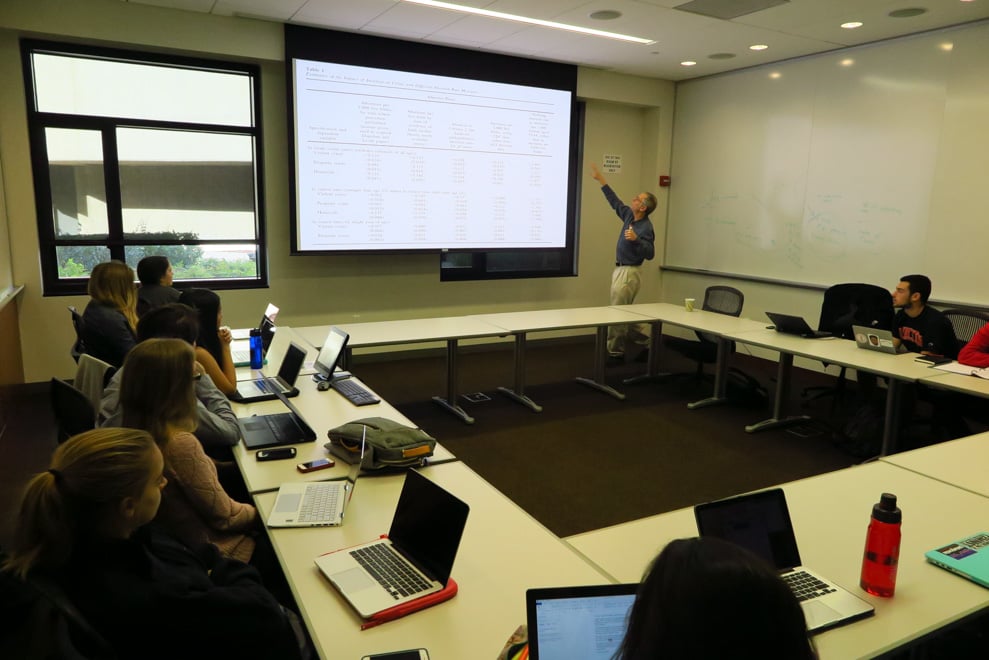
In LAW 116N: “Guns, Drugs, Abortion, and Empirical Evaluation of Law and Policy,” students learn to disentangle fact from fiction in some of society’s most controversial policy issues.
The new freshman Introductory Seminar tackles tough subjects with a scientific rather than a moral lens, attempting to find solid empirical ground in the midst of impassioned debate.
Students use statistical analysis to address questions that range from “Does abortion reduce crime?” to “Is the U.S. death penalty racially biased?” (According to law professor John Donohue, who teaches the course, the answers are “yes” and “yes.”)
“For a lot of these highly charged issues, there are quite an array of underlying empirical questions that can be answered, and yet people are still battling back and forth about them,” Donohue said.
“Facts have the potential to improve our democracy by making our battles over value judgments, as opposed to questions that can be resolved,” he added.
LAW 116N is among this quarter’s most popular Introductory Seminars, having received over 170 applications for just 16 spots. Donohue believes this high demand comes from a growing interest in data-driven analysis, as well as the bestselling book, “Freakonomics.” Donohue co-wrote an influential paper on the abortion-crime link with one of the book’s authors, Steven Levitt.
That abortion research was the subject of Donohue’s latest class. He explained to students how he and Levitt had sought to explain an “incredible” drop in crime in the 1990s — at a time when many were predicting skyrocketing crime and a coming “bloodbath of teenage violence.”
Ultimately, Levitt and Donohue’s research connected the crime decrease to the Supreme Court’s 1973 Roe v. Wade decision to legalize abortion. During the 1990s, the post-Roe v. Wade generation was just coming of age; Levitt and Donohue argued that that a decrease in unplanned births led to better overall outcomes for that era’s adolescents.
“I’ve definitely been forced to think about things I didn’t before,” said Isaac Justice ’19. “I wouldn’t say I’ve changed my opinions, but I’ve been opened to new ideas. Before [the class], I had just never thought about the effect abortion would have on crime.”
In addition, many LAW 116N students have received a crash course in statistics.
As an Introductory Seminar, the class is meant to be accessible to students without significant prior training. However, the class dives heavily into econometrics — the application of math, statistics and computer science to economic data. Students use a software package called Stata to analyze data from major empirical studies.
Donohue modeled the class after a course he teaches at Stanford’s law school, modifying the content to cater to a less-experienced group. This is his first time teaching undergraduates.
“When I told a friend who teaches at Berkeley what I was doing, he said ‘Oh my god, that’s impossible, you’ll leave the students behind,’” Donohue said.
But Donohue has been pleasantly surprised by his freshman students’ ability to keep up.
“The big challenge, which is part of the idea of the IntroSem, is…you throw students who haven’t gone through years of training in a particular discipline into contact with a professor who’s doing cutting edge research of some sort, and try to bring the students right up to the point of understanding,” Donohue said.
Students have learned to use Stata through a series of group projects. For their first project, Donohue simply asked students to play around with data from a study of Connecticut death penalty cases.
“The assignment was just to have fun,” Justice said. “It made the process of learning Stata a lot less painful than it could have been.”
For example, Justice and his group members tried to investigate if the “reality-TV-worthiness” of a death penalty case was more likely to result in execution, by analyzing the outcomes for especially odd crimes such as lovers’ quarrels and kidnappings.
Michael Bloomer ’19 said his group tried to find a combination of variables that would lead to the highest possible likelihood of a death sentence. In the end, they could find no stacking of variables more predictive of the death penalty than a black person attacking a white person.
“We think of the death penalty as justice, and it’s really very arbitrary,” said Billy Ferguson ’19.
Students said they have learned to look more critically at data and how it is presented. Ferguson described a study funded by tobacco companies that excluded lung cancer patients to make smoking appear beneficial to one’s health.
“You can do anything with numbers,” Ferguson said. “You can frame it in a way that does what you want. This class is teaching us how to know when the framing is wrong.”
Contact Hannah Knowles at hknowles ‘at’ stanford.edu.
